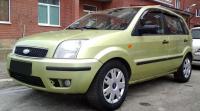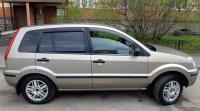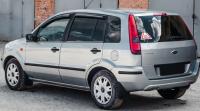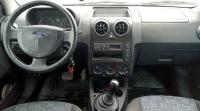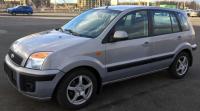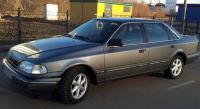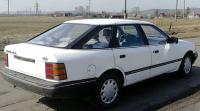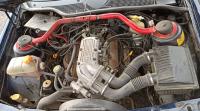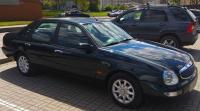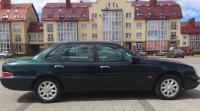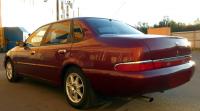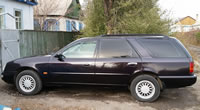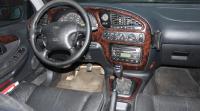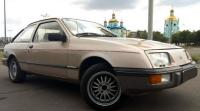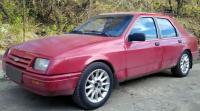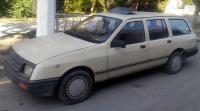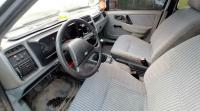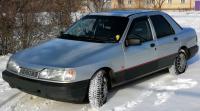Ford Fusion
Ford Fusion - a light five-seater American car of the compact minivan class, which was produced by the European division of the company «Ford Motor Company» With 2002 year on 2012 year. Platform based «Ford Fiesta», has a spacious interior with a high roof, folding seats and increased ground clearance. The engine is located transversely in front, front-wheel drive. The body is made in the form of a five-door hatchback with a length of 4020 mm, a width of 1710 mm and a height of 1503 mm, curb weight 1075 kg, wheelbase was 2488 mm. In 2012 it was replaced by «Ford B-MAX».
The car was shown at the Geneva Motor Show in 2001, and sales started at the end of 2002. Production was established in Germany and India.
Petrol engines were four-cylinder with 16 valves with a volume of 1.4 liters (1388 cm3, FXJA/FXJB, Duratec, 80 hp) and 1.6 liters (1596 cm3, FYJA, Duratec, 101 HP). Diesel engines were also four-cylinder 1.4-liter (1399 cm3, F6JA/F6JB, Duratorq, 68 hp) and 1.6 liters (1580 cm3, Duratorq, 90 hp), both turbocharged diesels. The gear box was a five-speed manual «IB5», five-speed semi-automatic «DuraShift-EST» or four-speed automatic «Aisin Warner AW-80».
In November 2005, they updated the model, changed the headlights and taillights, bumper, side linings, rear-view mirrors, interior design, dashboard, and also added a 1.6-liter diesel engine.
Ford Scorpio
Ford Scorpio - American business class car, which was produced by the company «Ford» With 1985 year on 1998 year. He replaced the European «Ford Granada». In America and Canada, for some time it was sold under the name «Merkur Scorpio». The body was in the form of a four-door sedan, five-door hatchback or station wagon. The engine was located longitudinally in front, rear-wheel drive, later all-wheel drive versions appeared. In total, 2 generations of this car were produced and in 1998 it was replaced by a large family car «Ford Mondeo».
First generation (1985-1994)
First generation with factory code «DE-1» was created to fill the European segment D and E and to compete with cars from Mercedes and BMW. For the design of the body was the use of advances in computer modeling and graphics. The car used a lot of relatively new options for that time - leather seats with electric and heated, air conditioning, electric sunroof, trip computer, heated windshield, cruise control, four-wheel drive, ABS, etc. Five trims were available: Standard, GL, GLS, CLX, Ghia. The dimensions of the body were as follows: a sedan and station wagon with a length of 4744 mm, a hatchback with a length of 4673 mm, a width of 1760 mm, a height of 1440 mm. The curb weight was 1380 kg.
The range of gasoline engines looked like this - four-cylinder 1.8-liter (1796 cm3, Pinto OHC, 90 hp), 2.0 liters (1993 cm3, Pinto OHC, 105/115 hp), 2.0 liters (1998 cm3, Ford DOHC, 120 hp), six-cylinder V6 with a volume of 2.4 liters (2397 cm3, Cologne OHV, 125/130 hp), 2.8 liters (2792 cm3, Cologne OHV, 150 hp), 2.9 liters (2933 cm3, Cologne OHV, 150 hp) and 2.9 liters (2933 cm3, Cosworth BOA, 195 hp). Diesel engines were three models, all with a volume of 2.5 liters (2498 cm3) — «Peugeot XD3» 69 HP, «Peugeot XD3T» (turbo) 92 hp And «VM 425 OHV» 116 hp Gearboxes were of the following models - five-speed manual «Type 9» And «MT-75» or four-speed automatic «A4LD».
In March 1992, the model was restyled. Changed the grille, headlights, taillights, hood and dashboard.
Second generation (1994-1998)
This generation was presented at the Paris Motor Show in October 1994. The appearance and equipment of the cabin has changed quite a lot, everything has become more rounded following the automotive fashion of the time. The design was met with mixed reception and was criticized in the automotive press. There are two types of bodies left - a four-door gray and a five-door station wagon. The length of the car was 4825 mm, width 1760 mm, height 1388 mm, wheelbase 2770 mm and curb weight 1577 kg. The drive remained on the rear wheels. There were three trim levels - Executive, Ghia and Ultima.
Gasoline engines are represented by the following models - 2.0 liters (1998 cm3, NSD, 8V, I4, 115 hp), 2.0 liters (1998 cm3, N3A, 16V, I4, 136 hp), 2.3 liters (2295 cm3, Y5A/Y5B, 16V, I4, 147 HP), 2.9 liters (2933 cm3, BRG, 12V, V6, 140 HP) and 2.9 liters (2933 cm3, BOB Cosworth, 24V, V6, 207 hp). The diesel engine was one with a volume of 2.5 liters (2498 cm3, SCD, TD, I4, 115/125 hp). The transmission is a five-speed manual or four-speed automatic.
In September 1997, the car received a facelift, with darker headlight surrounds and a thinner grille. In the summer of 1998, production was stopped.
Ford Sierra
Ford Sierra - big family car (D-segment), which was produced by the American company «Ford Motor» With 1982 year on 1993 year. The name is a Spanish word meaning «mountain range». Came to replace «Ford Cortina», produced for 20 years and 5 generations. It was first shown in September at the British International Motor Show in Birmingham. Its aerodynamic styling was ahead of its time, with a drag coefficient of 0.34 instead of 0.45 for «Ford Cortina». The main production was carried out in Germany, Belgium and the UK, but small batches were produced in other countries. Over 2.7 million cars have been built throughout the time. Has been replaced «Ford Mondeo» after production ended in March 1993.
The drive was on the rear wheels with a front engine. In 1985, an all-wheel drive was introduced at the Geneva Motor Show «Sierra XR4x4» with the transfer of 2/3 of the torque to the rear wheels. Body styles were as follows - three- and five-door hatchback, four-door sedan, five-door station wagon and five-door commercial van. The length of the car was 4531 mm, width 1727 mm, height 1367 mm, wheelbase 2609 mm and curb weight 1025-1075 kg.
For all the time of gasoline engines there were more than 10 models of the following characteristics - 1.3 liters (1294 cm3, Pinto, I4, 60 hp), 1.6 liters (1593 cm3, Pinto, I4, 75 hp), 1.6 liters (1598 cm3, CVH, I4, 80 hp), 1.8 liters (1796 cm3, CVH, I4, 80 hp), 1.8 liters (1796 cm3, Pinto, I4, 90 hp), 2.0 liters (1993 cm3, Pinto, I4, 100 hp), 2.0 liters (1993 cm3, Cosworth turbo, DOHC, 16V, 204 hp), 2.0 liters (1998 cm3, N8/N9, DOHC, I4, 115 HP), 2.0 liters (1998 cm3, Cologne, OHV, V6, 90 hp), 2.3 liters (2293 cm3, Cologne, OHV, V6, 114 hp), 2.8 liters (2792 cm3, Cologne, OHV, 150 V6, hp), 2.9 liters (2935 cm3, Cologne, OHV, V6, 160 hp), 3.0 liters (2994 cm3, Essex, OHV, V6, 157 hp) and 5.0 liters (4942 cm3, 5.0 HO, OHV, V8, 235 hp). Diesel engines were installed in two models with a volume of 1.8 liters (1753 cm3, Lynx TD, I4, 75 hp) and 2.3 liters (2304 cm3, Indenor, OHV, I4, 67 HP). The gearboxes were as follows - a three- or four-speed automatic, as well as a four- or five-speed mechanics.
In September 1987, a restyled «Sierra», and a four-door sedan was added to the range. In 1990, the second update of the model was carried out.
